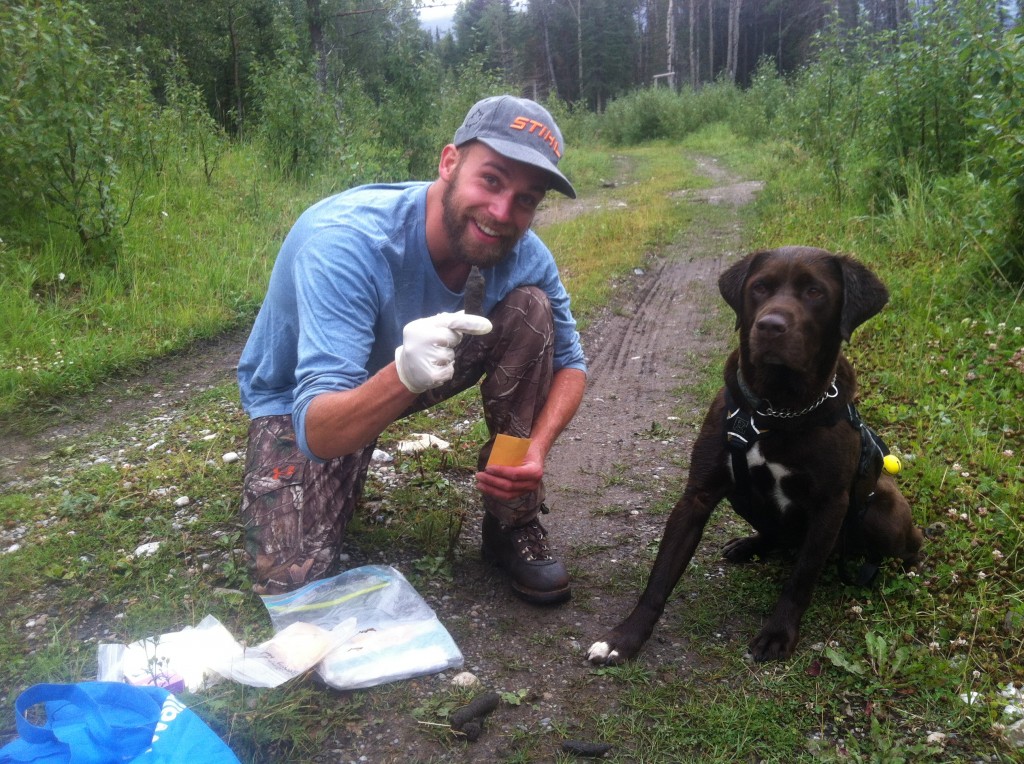This summer, a new member was added to the Ya Ha Tinda Elk Project: Eric Spilker. Eric is a MSc student and he will be collecting predator scats using scat detection dogs.
Eric gives us an exclusive update of his summer work. You will be surprised how much we can learn from poop!
So Eric, how did your first field season go ?
This summer field season we were able to complete our goal of surveying all 48 5 km x 5 km cells of the study area. Approximately 500 kilometers were covered on foot, with additional mileage added for access to some hard-to-reach cells. We found over 500 scats, and collected 332 . The dogs quite possibly enjoyed the work even more than the handlers. They were lucky enough to get a good long hike every day, plenty of pets, and over 500 games of fetch—it’s a tough life being a working dog!
That is a lot of scats collected in 4 months! By only two dog/handler teams! We are curious, what were you lucky to find ?
We found mostly wolf, with black bear, grizzly bear, and coyote having comparable, lower numbers. We found much fewer cougar and lynx. Possible explanations could be difficulty finding scat (they sometimes bury it rather than advertising it on a rock like a dominant wolf would do) or fewer felids on the landscape.
Now that summer is definitively over, what are you working on?
This fall we have begun our diet analysis, distribution analysis, and are preparing to have our DNA samples analysed. The diet analysis will involve inspecting the scat samples for undigested clues as to what the predator had consumed. In the lab, we are identifying hair, bones, seeds and undigested vegetation. The hair is examined through a microscope for very subtle hints as to what species and age class the prey species was, allowing for insight to which predators have the greatest percentage of calf elk in their diets.
Could you explain to our readers what a distribution analysis consists of ?
The distribution analysis is being performed using Geographic Information Systems (GIS). By plotting the location of the scats we collected on a map of the study area, we can see if there are patterns of different combinations of the predators on the landscape. This will allow us to produce maps of areas that suggest which areas might pose the most risk to cows and their calves. By comparing these areas with the locations of elk mortalities, we can learn more about important predator-prey interactions.
You also mentioned DNA samples. How will you extract it from a scat?
The DNA samples will be analysed to determine which predator species deposited the scat. DNA was collected from only the freshest scats. This is due to the fast degradation rates of DNA: exposure to UV radiation, moisture, and freeze/thaw cycles will all quickly break down the DNA structure. Rather than sampling the actual feces, the goal is to retrieve intestinal cells that are shed off and deposited along the outside of the scat as it is leaving the body. In the lab, it is a relatively simple technique of amplifying the mitochondrial DNA (there’s lots of mtDNA in every cell) using the tried-and-true Polymerase Chain Reaction.
What information will DNA provide?
This process makes repeats of small bits of collected DNA and produces a DNA “signature” specific to a species. Even though many of the scats can be identified in the field based on unique characteristics, there are many overlapping qualities between the species in the study area. For example, determining a juvenile grizzly bear from an adult black bear—or a juvenile cougar/wolf, from an adult lynx/coyote—can be a guess at the best of times. Ensuring that we are representing the correct species in our analyses is essential for having confidence in the data we will be using.
Thank you Eric for this amazing insight into a yet-to-be-widely-recognized methodology. This non-invasive method will deliver an extraordinary amount of information that will help better understand predator use of the landscape.
Now, we all want to know, what are your plans for 2015?
We are already getting prepared for another great summer in the field for 2015. We have made several minor revisions to our study plan and are confident that we will be collecting the answers to our questions!
Eric and Shrek, a winning team


